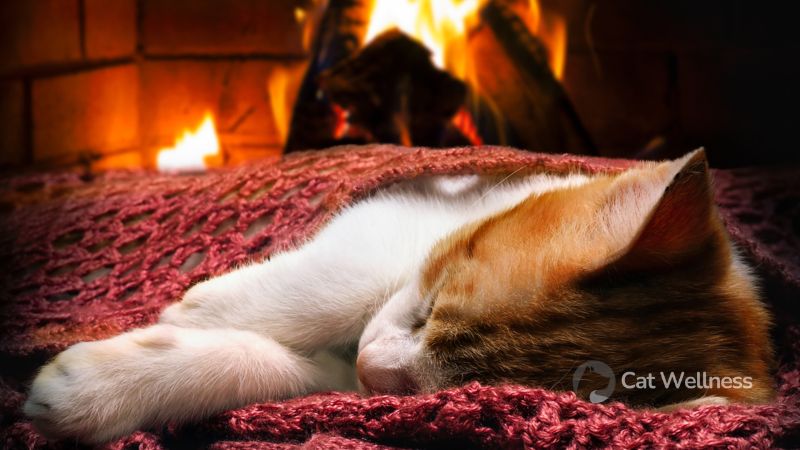“Can cats see fire?” is a fascinating question that explores the sensory perception of our feline companions. Cats are known for their acute senses, particularly their exceptional night vision, but can they perceive the fiery glow of flames like humans do?
In this exploration, we’ll delve into the unique characteristics of a cat’s vision and shed light on whether or not they can truly see fire.
Let’s check it out!
How Do Cats See The Visual System?
Understanding how cats’ visual system functions is crucial for determining whether they can perceive fire.

Photoreceptor Cells
Cats possess two kinds of photoreceptor cells in their retinas: rods and cones. Rods facilitate night and low-light vision, while cones are accountable for daylight and colour perception.
Cats have more rods than humans, enhancing their ability to see effectively in dim lighting.
Field of Vision
Cats boast a broader field of vision compared to humans, spanning roughly 200 degrees in contrast to the average human visual range of 180 degrees. This broader field allows them to detect motion more efficiently, making them adept predators.
Nocturnal Vision
Cats are renowned for their exceptional nocturnal vision. They possess a structure known as the tapetum lucidum located at the rear of their eyes, which reflects light onto the retina.
This reflection amplifies the amount of light that rods can capture, enabling cats to perceive objects more clearly in low-light situations.
Can Cats See Fire?
Yes, indeed. Cats possess the ability to perceive fire. Like humans, cats have the capacity for colour vision, allowing them to discern a wide spectrum of colours, including the ability to see fire and perceive the movement and brightness of flames.

Cats have heat sensors around their faces to detect heat, often indicating potential danger. While cats may be drawn to the warmth of a fire or the flicker of a flame, they usually react swiftly by either retreating or attempting to escape when they detect the scent of smoke.
Besides, cats possess a captivating ability to perceive various colours, although their perception may differ from ours. While humans can appreciate an extensive array of colours, cats have a more limited colour vision due to their fewer cone cells in the retina. It is generally believed that cats can perceive shades of blue and green but may struggle to perceive red.
Regarding perceiving fire, cats may not see the vibrant red and orange hues commonly associated with flames. Instead, they likely perceive the fire in shades of blue, green, or grey. Despite this limited colour vision, cats can still detect motion and brightness, which allows them to be aware of flickering flames.
Additionally, cats possess more rod cells responsible for detecting motion and functioning in low-light conditions than cones responsible for colour vision. This enhanced rod cell presence enables them to see better in the dark than humans.
While cats may not perceive colours and details as vividly as humans, their sensitivity to motion and changes in light make them keen and intriguing observers of their surroundings.
The Cat’s Eye Structure
To grasp the way cats perceive the world, it’s essential to delve into the structure of their eyes. Like humans, cats have corneas, irises, and pupils, but distinct differences contribute to their remarkable vision.
Enlarged Pupils
Cats possess disproportionately large pupils about their eye size. This unique characteristic enables them to collect more light, significantly improving their ability to see in low-light conditions. The expansion and contraction of their pupils also play a role in regulating the amount of light entering their eyes.
The Tapetum Lucidum
Another intriguing element of a cat’s eye is the tapetum lucidum. This reflective layer behind the retina enhances their night vision by reflecting light through the photoreceptor cells, allowing them a second opportunity to capture available light.
How Do Cats Respond to Fires?
Cats typically rely on their sharp sense of smell to detect smoke and signs of danger when it comes to fires. Once they pick up on these warning signals, they usually try to exit the area quickly.

This may involve them rushing to a safe room or even leaping out of a window. While cats generally steer clear of fire and avoid intentionally touching it, they could still get hurt or trapped amidst the chaos of a burning building. Therefore, cat owners must have an evacuation plan in case of emergencies.
By taking early action and being prepared, you can ensure the safety and well-being of your feline companions during a fire incident.
What Are the Consequences If a Cat Comes into Contact with Fire?
A cat can suffer from thermal burns if it touches or gets too close to fire. These burns occur when a cat encounters extreme heat sources, like an open flame from a candle or fireplace.
The cat is likely to experience pain and discomfort, and the severity of the burns depends on the heat’s intensity and exposure duration. It’s important to remember that while cats have excellent vision and can see fire, it could be clearer if they comprehend its danger.
Therefore, pet owners must be aware of potential risks and always supervise their cats near heat sources or flames.
Do Cats Understand the Danger of Fire?
Cats have some awareness of the danger associated with fire. While they may not fully grasp the concept of fire as humans do, they can sense the heat and smell of smoke. However, it’s important to emphasise that cats don’t necessarily comprehend that fire is hazardous.
They won’t intentionally approach flames, but they might be captivated by the visual aspect of fire. As responsible pet owners, we must educate ourselves about potential fire hazards in our homes and take preventive measures to safeguard our beloved pets.
Although we can’t expect our pets to alert us to a fire, we can proactively protect them from potential dangers.
FAQs
Can cats sense heat from a fire?
Yes, cats can sense heat from a fire. They have sensitive whiskers and can feel temperature changes. If a fire is close enough, they may feel the heat and react to it as a threat or danger.
Are cats attracted to fire?
A3: Generally, cats are not attracted to fire. Most cats are naturally cautious and will avoid fire because they instinctively recognise it as a potential danger. However, some cats may be curious and approach flames out of curiosity, so keeping them away from open flames is essential for their safety.
Can cats get burned by fire?
Yes, cats can get burned by fire if they come into contact with it. Cats have fur, which is flammable, and their skin can be susceptible to burns if exposed to flames or hot surfaces. Keeping cats away from open flames and hot objects is crucial to prevent burns.
Do cats react to the smell of smoke from a fire?
Cats have a highly developed sense of smell so they may react to the smell of smoke from a fire. They may become agitated or nervous if they detect the scent of smoke, which is a natural response to a potential threat.
Conclusion
In summary, cats possess the ability to detect and respond to fire. They can perceive the motion and intensity of flames and also have heat sensors around their faces.
When they sense the presence of a fire, cats typically try to escape upon detecting the scent of smoke. Pet owners must understand the fire hazards and take preventive measures to avoid accidental fires.
While cats may be drawn to fires and fireplaces for warmth, keeping them away is essential to prevent accidents or injuries. With vigilance and awareness, cats can safely live alongside a house’s fire.
Recommended Reading



























